
Original Link: https://www.anandtech.com/show/2670
Thermaltake TR2 QFan Series
by Christoph Katzer on November 19, 2008 3:00 AM EST- Posted in
- Cases/Cooling/PSUs
Introduction
It has been sometime since we've seen a major brand like Thermaltake launch a new series of power supplies designed to address the needs of moderate users. We first saw Thermaltake TR2 QFan series at CES or CeBIT earlier this year, but the products haven't appeared in the retail market yet. We received test samples a few months ago, still with no sign of retail product, but Thermaltake assures us availability will occur during the next month.

The TR2 QFan series' claim to fame is limited to one area, and it's not even really a feature. What's so special? The series starts with a modest 300W unit, and ranges up to 500W in 50W increments. We will be looking at four of the units today -- everything except the top 500W model.
The QFan part of the name comes from the use of Thermaltake's patented fan design, which is supposed to decrease noise levels at higher fan speeds. Unfortunately, last time we looked the fan was just as noisy as any other fan design, but at least we can look forward to testing some decent power supplies that cater to users that don't need hundreds of watts of power. Finding good quality PSUs for this market has become increasingly difficult, and Thermaltake could step in to fill the void.




As you might expect, the differences between the various models are generally small. The 3.3V and 5V rails in the 300 and 350W unit are rated at 15A and 21A, respectively, while the 400W and 450W units are 15A and 24A. The 300W version comes with two 12V rails at 11A and 8A compared to the 350W version's 11A and 14A. The 400W and 450W also have different 12V ratings, with 17A on 12V1 and 14A (400W) and 16A (450W) on 12V2. All of this is in line with the higher output ratings, though there will also be some differences on internal components in order to support the higher wattages.
Packaging and Appearance


Thermaltake is one of many companies currently jumping on the "green" trend of saving mother earth. Sometimes marketing can go a bit far, but we got a chuckle out of the green plastic leaves inside the boxes. The units themselves all have the same packaging, with modified paper sleeves for the appropriate model. Inside the box are power supply, a small manual, warranty card, screws, a power cable, and a silicon anti-vibration kit.

The power supplies all use Thermaltake's standard gunmetal color, which looks nice when paired with the shrinking hoses on the cables. The QFan design is also visible, with long slot perforations on the rear of the unit. The idea is to increase airflow, but in practice we didn't notice any improvements in performance, temperatures, or fan noise.
Cables and Connectors

Cable sleeving begins just beyond where the cable harnesses leave the front of the power supply. We tend to think it looks nicer if the sleeving begins inside the power supply casing, but it's not a huge issue and personal opinion plays a role. Also somewhat odd is that Thermaltake provides the same number of cables and connectors, with identical cable lengths on all of the TR2 power supplies. That means users get plenty of connectors on 300W model, but the 450W unit trimmings seem a bit spartan in comparison. We would have liked to see an 8-pin EPS 12V connector or an additional 6-pin PEG connector. Still, there are sufficient Molex and SATA connectors for all kinds of users.
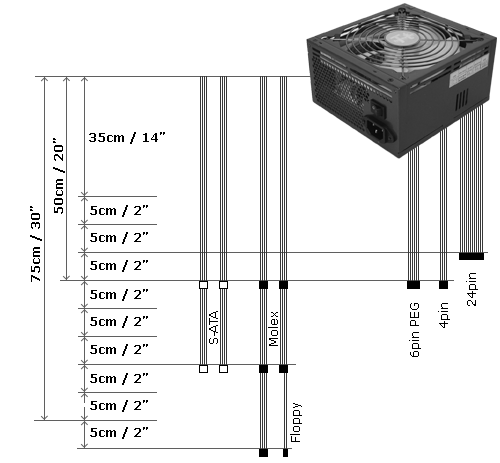
The Fan


The fan is completely open on all sides. Thermaltake states that the patented design increases airflow and reduces noise, but it was difficult to confirm this in testing. The fan carries a Thermaltake mark, but it's manufactured by Everflow in China.
Internals

Given the target market, we don't expect a top quality internal design. Most companies say those for their higher end models, for the simple reason that such designs cost more and no one is going to want to spend over $100 on a 300W power supply. We can only hope that one day we will begin to see better topologies on lower wattage models.
As far as the QFan, we see minimal components on the input filtering stage in the internals are very sparse in comparison to higher-end PSUs. Of course, if you only need to output 300W to 450W, you don't need a lot of extra components. We find a standard CWT design three heatsinks, two for the primary side. Thermaltake uses Hitachi capacitors for the primary and SamXon caps on the secondary side. We don't have any complaints about the Hitachi caps, and even though SamXon is a cheaper offering, we haven't encountered any problems with their capacitors in previously tested power supplies.
Testing with the Chroma ATE Programmable Load
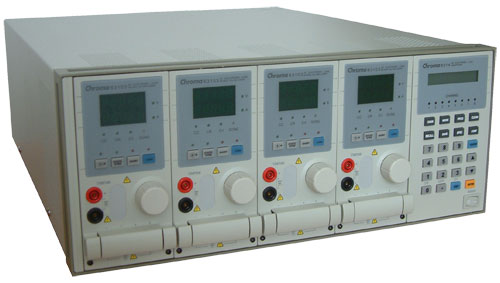
Our test equipment consists of two Chroma programmable DC Loads that enable us to test power supplies with an output of up to 1500W. The biggest advantage of the Chroma DC Loads is simply the high precision it provides. It can measure differences as small as 0.001V and 0.0001A, which will provide us with best-in-class results.
When programming the Chroma with specific amounts of load calculated according to the ATX norm, we are able to load power supplies to an exact percentage. We can now show results at every specific percentage needed. To get the best overview of a power supply, we load each unit with 10%, 20%, 50%, 80%, 100%, and 110% of the specified output. This is easy to calculate for a 1000W power supply: the 10% load is 100W and 110% load is 1100W. Remember that this is the amount of power the PSU delivers; due to inefficiencies, a power supply will actually draw more power from the wall.
Note: If you would like to know more about our testing methodology, equipment, and environment, please read our PSU testing overview.
We have added an additional 10% on the highest load to see how the units perform with overload. This test will be performed in all future reviews. The overload test is performed at room temperature as well as under more stressful conditions; to ensure we are not too cruel to the power supplies, we will keep the ambient temperature at 50°C in the stress test. Experience shows that many units can stand the overload at room temperature but will experience problems with higher temperature and overload together. Only the best-built units will survive this.
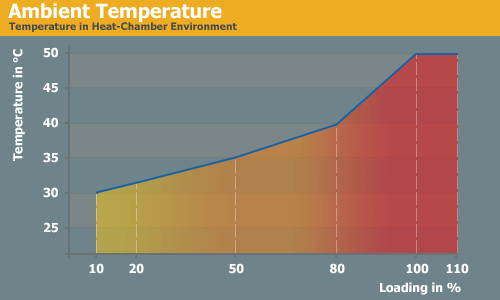
The Testing Environment
There is one flaw in testing power supplies with programmable loads while trying to measure the sound pressure levels at the same time. Because the programmable loads get very loud, there is no chance of hearing the power supply on the test stand. In order to make accurate measurements of the noise levels we needed a way to separate the test unit and the programmable loads. Our solution was to build a very thick box around the unit.
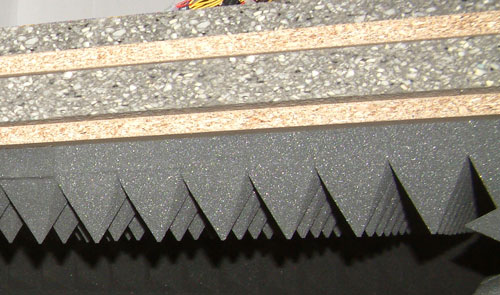
We concluded that a five-layer box with a total thickness of 6" (15cm) containing two layers of wood and three layers of special foam would suffice. It is designed as a box within a box. The inner box does not touch any part of the outer box, making it difficult for acoustic noise to pass through in the form of vibration. Each box is isolated on both sides with a layer of heavy foam that is normally used to insulate engines. On the inside we have an additional layer of 4" (10cm) thick pyramidal foam on every side of the box to eliminate the acoustic waves coming from the test object as well as we can.
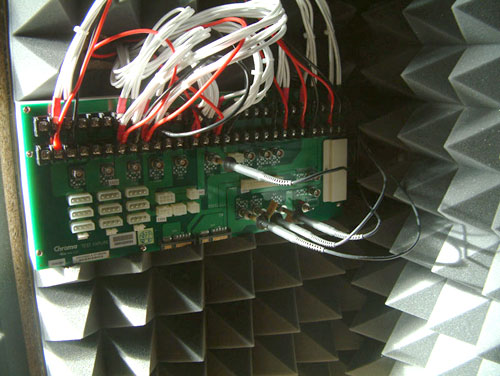
To ensure a completely closed system we installed the printed circuit board that the connectors of the power supply are attached to inside the anechoic room/box. In other box designs, you would need to put all the cables through the wall. Unfortunately, that would result in the inside of the box not being fully isolated anymore. Our design keeps everything that needs to be connected inside of the box and maintains isolation.
DC Output Stability and Quality
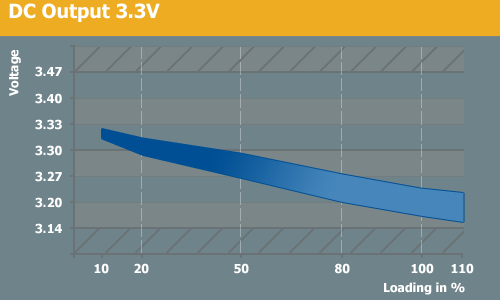
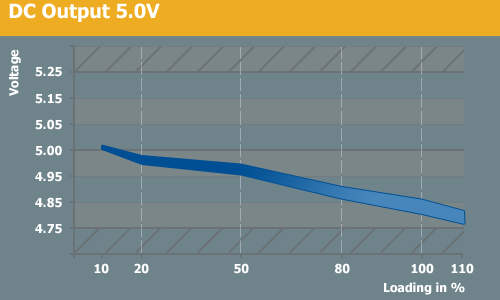
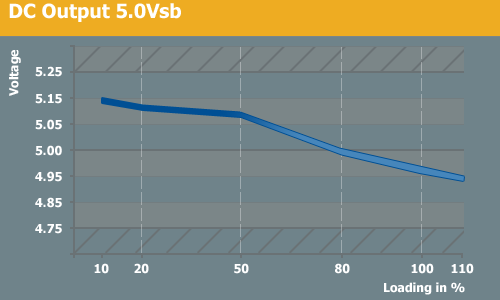
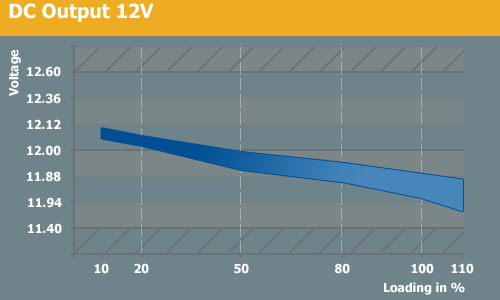
We decided to group all for power supplies into a single chart for each of the voltage rails. All four units have the same topology and the components are about 99% the same, so there were very few differences and it was very easy to combine the results into one chart. The 3.3V rail shows the largest spread between the models, with some of the units coming close to dropping out of spec at maximum load. The 5V rails also drop to the low end of being in spec. The 12V rails on all of the units are decent but not great, showing a total voltage regulation of 5%.
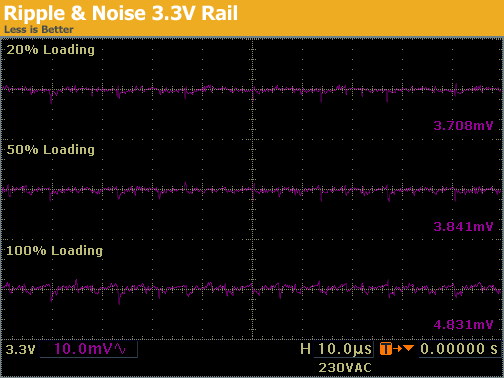
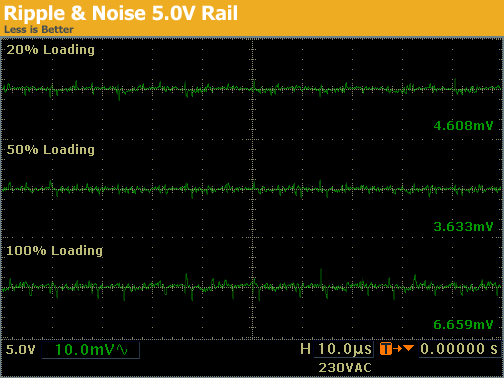
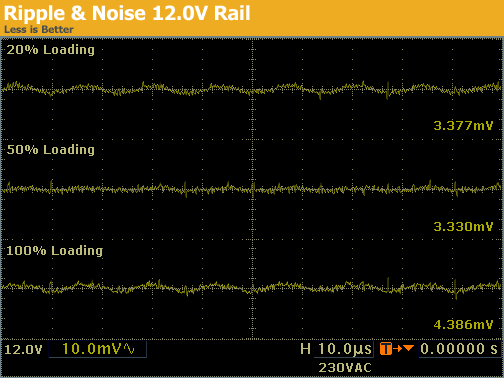
The ripple and noise were surprisingly very small, and we of course tested all of the units. There are minimal visible spikes, so this CWT built power supply at least does well in that regard.
Efficiency and PFC
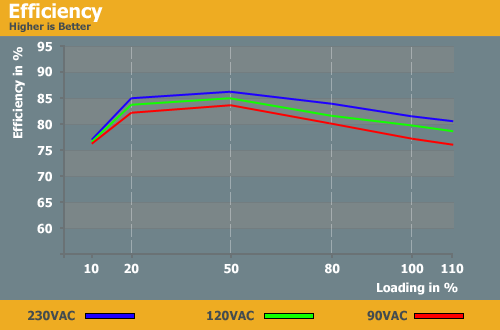
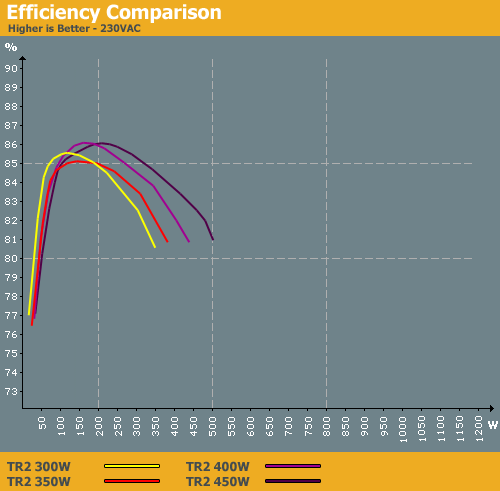
Efficiency was consistent across the four tested units, with differences of only 1%-2% at the various loads. Only the 350W model failed to reach 86% efficiency, topping out at 85% instead. As we discussed recently, small differences in efficiency aren't a major concern. All of the tested models also stay above 80% efficiency as long as the load is at least ~10%, so these power supplies would be a great fit for entry-level to midrange systems.
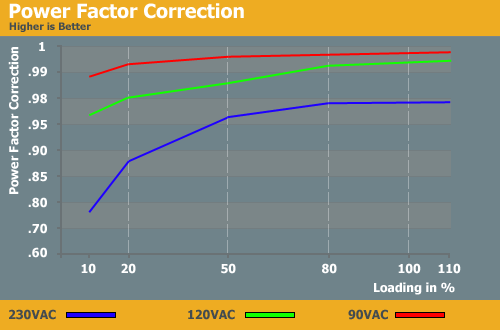
The power factor correction only reaches .98 with 230VAC - acceptable but it could be better. Lower input voltages as always have better PFC.
Temperatures, Fan Speed, and Acoustics
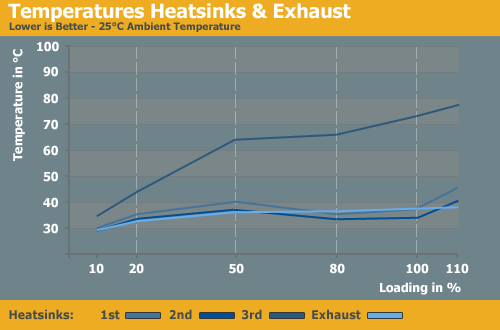
Both primary heatsinks hold stable at up to 40°C throughout testing, only surpassing that threshold when we overload the power supply. It's also nice to see that temperatures immediately decrease once the fan starts spinning faster. Of course we need to keep in mind that the heatsinks and fan don't need to deal with nearly as much heat, since these are only 300W to 450W PSUs. That's one of the benefits of using a smaller power supply.
We have previously commented that we didn't like the standard CWT heatsink design, with their "umbrella" fins blocking airflow and failing to dissipate heat as well as we would like. This time, due to less produced heat and a desire to cut costs, CWT used smaller heatsinks and the different temperature results are immediately visible. The only complaint we have is with the third heatsink; it should be larger, since even at room temperature it reaches up to 80°C.
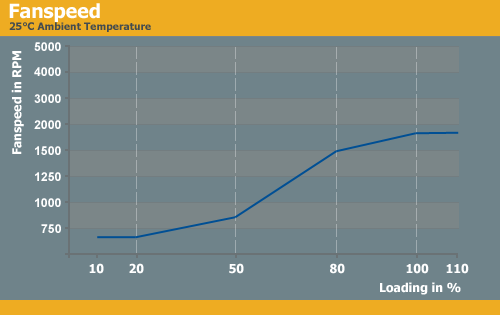
The fan spins at a very tame 650RPM for the first couple loading stages. Once we reach 50% load, fan speed quickly begins to ramp up and is at 1500RPM with 80% load. The good news is that the heatsinks immediately get cooler, but the drawback is increased noise output. With a slightly better heatsink design and improved fan speed control, it should be possible to keep temperatures and noise levels down.
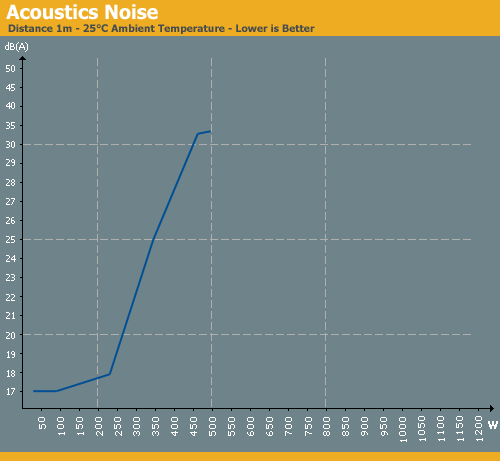
The acoustic noise develops fast with increasing fan speed. Going from 650RPM to 1500RPM brings a nice fat 10dB(A) increase in noise, which is not very good. The maximum noise output of 33dB(A) is unfortunately very loud. We strongly recommend that users interested in keeping noise levels down try to stay under 50% of the rated PSU output.
 |
Conclusion
The first time we saw the TR2 QFan on the show floor, we were extremely happy to see that someone was still planning to offer a good PSU targeting users that need less than 500W. The four power supplies we've tested today perform very well and we have no problem recommending them to anyone putting together a moderate PC. All we need now is retail availability.
In terms of features and performance, the QFan marketing sounds nice but we didn't see any actual benefit in testing. Thermaltake also cut corners in other areas to keep costs down; some of the cost cutting measures will matter, but others are trivial. Packaging for example uses the same simple box for all of the units, with the only difference being the large paper wrap that lists the wattage. All of the cables and connectors on the various units are also identical, as the bigger concern.
The connectors are a little limited on all of the units, with a maximum configuration being a GPU that requires two 6-pin PEG connectors. The 12V rail is also a concern, but typical midrange graphics cards should run fine even on the smallest 300W unit. There are also sufficient Molex and SATA connectors on hand for most users looking at this range of power supply.
DC regulation is average with around 5% on all rails. The 3.3V rail differs among the four units we tested, but the other rails are all similar. The efficiency ratings are great for lower output PSUs, and all of the units reach 85% to 86% maximum efficiency with 230VAC. That will be a great selling point for these units and we hope that more people will actually pay attention to these results.
As for the fan speed and the resulting acoustical noise, we can say that the fan control works well; with increasing temperatures, the fan spins faster. We just don't see the sense in advertising a promising feature like the QFan that actually doesn't seem to add much to the package. The temperature of the first two heatsinks stays below 40°C, but the secondary heatsink temperature reaches 80°C, which is not very good. As mentioned earlier, a larger heatsink should perform a little better.
With all of the power supply companies heavily marketing their high-end, high capacity PSU models, it's difficult to gauge how much interest there will be in good quality 300W to 500W PSUs. Even Thermaltake doesn't appear to be very bullish on the subject, as we first heard about the TR2 series over eight months ago.
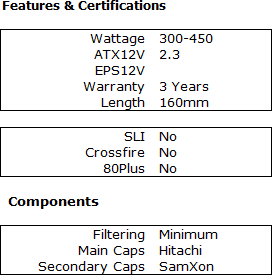 |
Even after all this time, these units are still not available on retail shelves, so we don't know what prices will be. We can only hope that Thermaltake will manage to offer these power supplies at a reasonable price, so that more users will end up purchasing something appropriate to their needs. Not only does it cost more money to purchase a 600W-1000W PSU, but if you aren't routinely drawing 300W+ of power such large PSUs end up being less efficient. If all you need is a single 6-pin PEG connector for your graphics card, and you don't plan to heavily overclock your system, the Thermaltake TR2 QFan series of power supplies should be near the top of your shopping list.

























